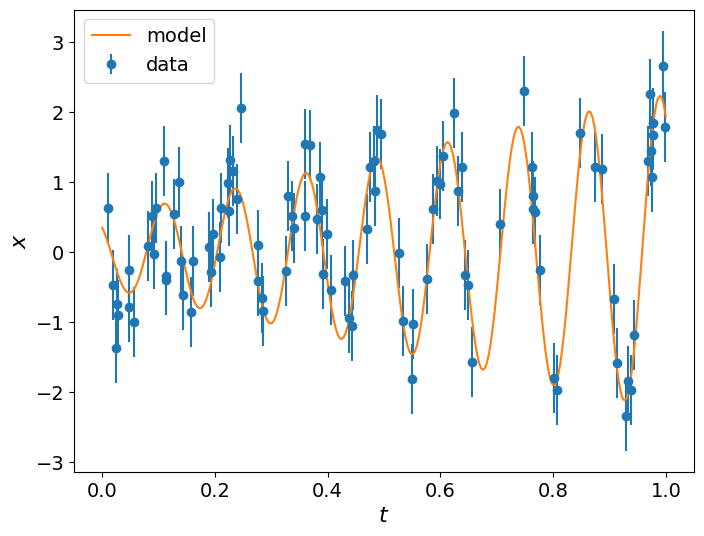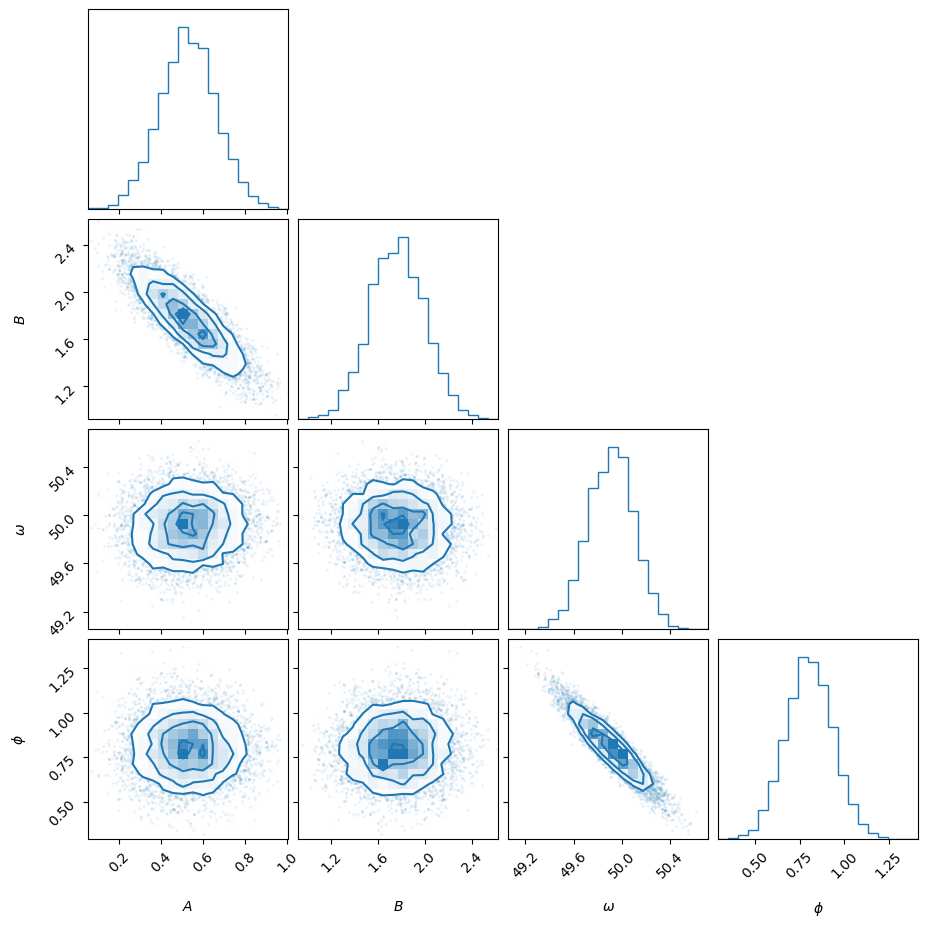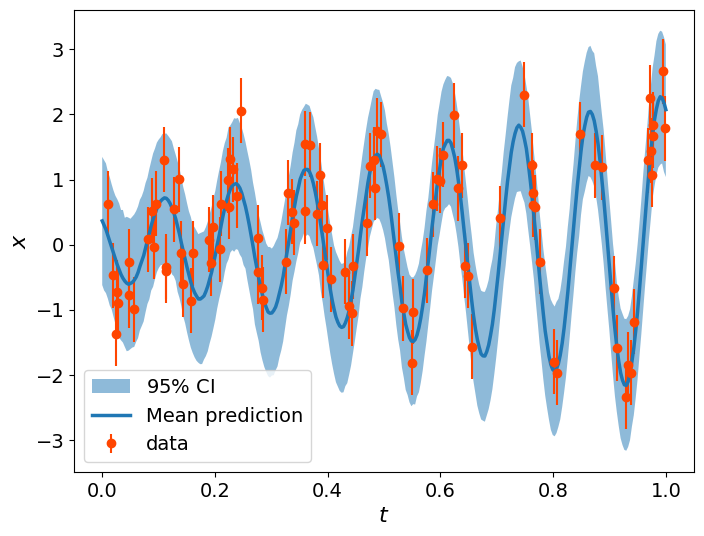Fitting a model to data#
In this tutorial we will see how one can use pocoMC to fit a model to some data.
The model that we will use is a cosine oscillation of frequency \(\omega\) and phase \(\phi\) with a linearly-evolving amplitude:
As usually, we begin by importing numpy, matplotlib and of course pocoMC:
import numpy as np
import matplotlib.pyplot as plt
import pocomc as pc
Defining the model and generating the data#
We define the model as function that accepts an array of parameters and an array of the time instances. We then use the same model to
generate some data by specifying the true parameters (these will be what we will attempt to estimate), a noise level sigma and the
time instances t. Finally, we plot the data along with the model that we used to generate them.
# Model with linearly-evolving amplitude
def model(params, t):
A, B, omega, phi, = params
return (A + B * t) * np.cos(omega * t + phi)
# True parameters
params_true = np.array([0.5, 1.75, 50.0, 0.8])
# Time instances corresponding to available data
t = np.random.uniform(0.0, 1.0, 100)
idx = np.argsort(t)
t = t[idx]
# Standard deviation of Gaussian noise of the data
sigma = 0.5
# Simulated data
data = np.random.normal(model(params_true, t), sigma)
# Time range used for plotting only
t_range = np.linspace(0.0, 1.0, 300)
# Figure
plt.figure(figsize=(8,6))
plt.errorbar(t, data, yerr=sigma, fmt="o", label='data')
plt.plot(t_range, model(params_true, t_range), label='model')
plt.xlabel(r'$t$', fontsize=16)
plt.ylabel(r'$x$', fontsize=16)
plt.xticks(fontsize=14)
plt.yticks(fontsize=14)
plt.legend(fontsize=14)
plt.show()

Prior probability distribution#
We first need to define the prior distribution for our problem.
We will assume that the prior for each parameter (e.g., A, B, omega, phi) is uniform. This can be
specified using the unif class from scipy.stats. unif accepts two arguments, the lower
bound L and the width of the prior W, where the width W is simply the difference of
the upper bound U from the lower bound L, that is W=U-L.
We can then combine the independent priors for each parameter into a joint prior distribution using
the Prior class object of pocoMC.
from scipy.stats import uniform
prior = pc.Prior([
uniform(-5.0, 10.0), # A in [-5, 5]
uniform(-5.0, 10.0), # B in [-5, 5]
uniform(10.0, 100.0), # omega in [10, 100]
uniform(0.0, np.pi), # phi in [0, pi]
])
Any scipy.stats probability distribution object can be in the Prior. For instance, prior = Prior([uniform(0,1), norm(0, 1)])
is a 2-dimensional prior probability distribution where the first parameter is uniformly distributed in [0,1] and the second is
normally/Gaussianly distributed with mean 0 and standard deviation 1.
Log-likelihood function#
We then define the log-likelihood function
# Log-likelihood functions
def log_like(params, t, data, sigma):
m = model(params, t)
diff = m - data
return -0.5 * np.dot(diff, diff) / sigma**2.0
Initialising and running Preconditioned Monte Carlo#
We initialise the sampler by providing:
the log-likelihood function
log_like,the prior probability object
prior,a list
likelihood_argswith the additional arguments that enter in the log-likelihood functionlikelihood,
# Sampler initialisation
sampler = pc.Sampler(prior=prior,
likelihood=log_like,
likelihood_args=[t, data, sigma],
)
# Run sampler
sampler.run()
Iter: 38it [03:48, 6.02s/it, calls=5e+4, beta=1, logZ=-57.3, ESS=4.97e+3, accept=0.865, steps=1, logp=-47.2, efficiency=0.832]
Results#
We can get the results from the posterior() and evidence() methods.
Posterior samples#
samples, weights, logl, logp = sampler.posterior()
import corner
fig = corner.corner(samples, weights=weights, labels=[r'$A$', r'$B$', r'$\omega$', r'$\phi$'], color='C0')
plt.show()

You can also resample the samples (i.e., make them have equal weights). The resampled points can be used just like you would do with MCMC samples.
resampled_points, _, _ = sampler.posterior(resample=True)
We can also compute any expectation values we want using the posterior samples.
print('Mean values = ', np.mean(resampled_points, axis=0))
print('Standard deviation values = ', np.std(resampled_points, axis=0))
Mean values = [ 0.52903128 1.76190206 49.91035108 0.80430747]
Standard deviation values = [0.13387134 0.23280674 0.18780775 0.13275501]
Bayesian Model Evidence or Marginal Likelihood#
To compute the estimate of the marginal likelihood log Z and its standard deviation, you can use the evidence() method.
logz, logz_err = sampler.evidence()
print("logZ =", logz, "+-", logz_err)
logZ = -56.454248481584564 +- 0.027575420864617416
Posterior predictive check#
Finally, we can perform some Posterior Predictive Checks to assess the predictive performance of our fit.
The distribution that reflects the probability of new data given the current data is the posterior predictive distribution:
where \(P(D_{new}|\theta,D) = P(D_{new}|\theta)\) assuming \(D_{new}\) is independent of \(D\).
The easiest way to sample from the posterior predictive distribution is to use the posterior samples that we have already to generate the new data.
sim_data = []
for params in resampled_points:
sim_data.append(np.random.normal(model(params, t_range), sigma))
sim_data = np.array(sim_data)
plt.figure(figsize=(8,6))
plt.fill_between(t_range, np.percentile(sim_data,2.5,axis=0),np.percentile(sim_data,97.5,axis=0),alpha=0.5, label=r'$95\%$ CI')
plt.errorbar(x=t, y=data, yerr=sigma, marker='o', ls=' ', color='orangered', label='data')
plt.plot(t_range, np.mean(sim_data, axis=0), lw=2.5, label='Mean prediction')
plt.xlabel(r'$t$', fontsize=16)
plt.ylabel(r'$x$', fontsize=16)
plt.xticks(fontsize=14)
plt.yticks(fontsize=14)
plt.legend(fontsize=14)
plt.show()
